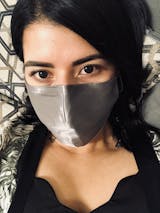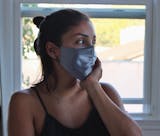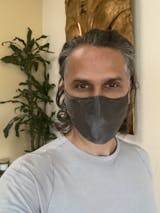For anyone who has ever suffered from acne, you’ll understand the effect it can have on your confidence—particularly during your adolescent years. When we suffer from acne, all we want is for it to be gone. But even after the acne clears up, there is one thing that can remain that can also have an equally negative effect on our self-esteem: acne scarring.
Acne scarring usually starts off as red marks, often accompanied with inflammation. If acne is not treated properly, red marks can turn into darker spots, and eventually more permanent scarring that can appear as pitts in the skin.
In this article I’ll discuss the types of scarring we can get, how to avoid them when you have acne, and how to minimize scars the safe way using effective natural ingredients.
Types of Scarring
Scars are identified as a mark left on the skin or within body tissue where a wound, burn, or sore has not healed completely and fibrous connective tissue has developed.
I’d be surprised if there was an adult alive right now who didn’t have any scars on their face or body. It’s a rite of passage that we get at least one decent scar from the time/s we’ve fallen off our bicycle as a kid; or accidentally cut ourselves in the kitchen; or stood on a broken beer bottle at the park; or had acne as a teenager.
In movies, often the villain, and sometimes even the hero has a noticeable scar. This is because scars tell a tragic or courageous story. They give a person more character and depth. Though, if I told you the story of my acne scars, it wouldn't be an epic tale. It’d be an awkward anecdote more than anything.
There are four types of scars:
- Keloid Scars
- Contracture Scars
- Hypertrophic Scars
- Pitted or Sunken (Acne) Scars
As we age, our collagen production slows down. Our face starts to thin out, our bone structure is more noticeable, as the youthful plumpness starts to diminish. So any scars on your face, no matter how small, end up being more visible the older you get.
I have a scar on my top lip from my early 20s that most people never noticed before. But I’ve had quite a few people ask about it in the past couple of years (now that I’m in my mid-30s) and it’s because it is more noticeable. Even my acne scars that I have had for 20 years are a little more noticeable than before. Aging is unavoidable, but acne scars don’t have to be.
How to Avoid Acne Scarring
Stop Picking Your Pimples
The best advice you’ll ever get on this topic is to leave your acne alone. This was something that I didn’t do as a teenager. I came from a long line of pimple poppers, so I just couldn’t help myself. But it is honestly the best and first line of defence against acne scars.
I know how satisfying it is to pop a pimple that has grown into a gigantic, white pustule—especially when it’s on your face where everyone can see it. But let me explain what happens when you do that.
A pimple is essentially just a hair follicle that has become congested and clogged with bacteria, oil, and sebum. It does not mean that you are dirtier than other people. It just means that your sebaceous glands—where oil and sebum are produced within the follicle—are more active.
Many people who suffer from acne are prone to having oilier skin, but this isn’t always the case. Our oil and sebum is a protective mechanism for our skin. But when we have dry skin, and are not giving our skin adequate moisture or hydration, our sebaceous glands can go into overdrive producing excess oil in order to try and protect our skin from external aggressors. This can result in acne.
What’s even more frustrating is, if you are not keeping your skin hydrated, eventually your skin’s protective barrier will start to break down. The result is skin that is red and inflamed. But when we treat acne, most of us want to use active, often aggressive products to kill the bacteria, but this is the wrong approach as it just damages our skin even further.
When you pop a pimple, you’re actually breaking the top layer of the skin in an uneven fashion. This more than likely leads to scarring, even if you can’t see it with your naked eye.
However, what happens underneath the skin is even more worrying. A hair follicle is around 4-7mm long depending on the location on the body. It runs from the epidermis (outermost) layer and ends in the dermis (middle) layer. When a follicle is clogged with bacteria it expands the follicle wall.
If you don’t squeeze a pimple in the correct way—most estheticians were taught how to do this back when I was in school almost twenty years ago, but I have heard that it is not common practice anymore due to the damage it can cause—you risk rupturing and forcing the bacteria through the follicle wall and either into a neighboring follicle where the pimple often doubles in size, or it ends up in the skin cells where it can cause an infection and inflammation.
So while scarring should be good enough motivation not to squeeze your pimples, the spread of bacteria should be an equally good motivator. Stop picking your pimples!
See a Skin Specialist
The obvious and most effective way to manage acne and avoid scarring is to see a skin specialist. They have the latest technology and are the most advanced in skincare.
There are ways skin specialists can reduce or remove scarring, which include:
- Collagen or fat fillers.
- Steroid injections.
- Laser resurfacing.
- Microneedling.
- Radiofrequency treatments.
- Dermabrasion.
- Chemical peels.
- Face lifts.
- Botox®.
But there are two issues with seeing a skin specialist:
- It isn’t cheap. Skin treatments can be tens to hundreds of dollars per treatment.
- It often isn’t ethical or sustainable. Many specialists use clinical-grade products, which are often tested on animals or made from animal by-products.
But if you truly are having problems with acne, and you cannot get it under control, I would recommend seeing a skin specialist. It is becoming more common for skin specialists to choose cruelty-free and vegan products for their clinics, you just need to do your research before choosing one.
Use Quality Synthetic Ingredients
Not all are bad, but many of them can be. When we recommend synthetic ingredients, they have to tick a couple of boxes:
- Ethical: no worker exploitation; vegan; no animal testing.
- Sustainable: only safe, clean, and good quality ingredients.
The products synthetic ingredients are found in also need to come in sustainable packaging, because it isn’t just what’s inside that counts. The outer packaging is what ends up in our landfills and oceans, after all.
As I mentioned above, not all synthetics are bad. In fact, many scientists are able to mimic natural ingredients in a lab, so the molecular structure of the synthetic is identical to the natural alternative.
Why do this? Why not just use the natural version? Well, natural ingredients can sometimes be difficult to maintain the safety and purity. Whereas a synthetic alternative can be managed and manipulated to ensure it is always safe.
Another reason is the sustainability angle. If it’s a natural resource, it can be over-harvested, like bakuchiol that grows only in parts of India. Bakuchiol became popular not too long ago because of its retinol-like properties, minus the skin irritation that retinol can cause. But today, bakuchiol is considered an endangered plant species thanks to overharvesting—way to go Beauty Industry.
Another reason is that some ingredients, like mica for example, are mined in developing countries. But, as many of you know, sourcing from developing countries can leave the workers open to exploitation, child labor, and unethical practices.
This is why many sustainable beauty brands, like Āthr Beauty, use a blend of US mined mica and synthetic made mica to avoid the possibility of worker exploitation and over-harvesting. River Organics also choose to use high quality, synthetic mica in their formulations for the same reasons.
Synthetic mica, for anybody wondering, is completely safe for use, and as mentioned before, the quality can be maintained and managed a lot better than naturally-mined mica.
Safe synthetically-made ingredients that are effective at fading acne scars:
- Salicylic acid—although it is derived from the bark of a willow tree.
- Alpha hydroxy acids (AHAs)—but you can also get natural alternatives.
- Sulphur—again, also found in nature, but often reformulated in a lab.
Use Natural Ingredients
There’s a reason why many Ancient rituals and ingredients have stood the test of time. It’s because they work. I’m talking specifically about Ayurveda, and even ancient Aztec and Mayan rituals.
When we look at Ayurveda, for example, there are hundreds of natural ingredients that are still being used to treat skin and our overall health and wellness.
M.S.Skincare is a great example. Their core business model is built on the incorporation of ancient Ayurvedic tradition with modern science. A few common ingredients used in Ayurveda that are also effective for acne or healing acne scarring include:
- Neem - antibacterial and anti-inflammatory
- Turmeric - anti-inflammatory and brightening
- Holy Basil - antibacterial and brightening
- Gotu Kola - healing and skin regenerating
- Licorice Root - brightening and evening-out skin tone
- Sandalwood - sebum regulating, fades dark spots, exfoliating
Nopalera uses one of Mexico's most abundant plants in their formulations: cactus. Cactus, or nopales, have been used for centuries as food, skincare, and medicine due to their incredible properties.
Cactus. high in vitamins A, D, E, and K, is known for its antioxidant, healing, anti-inflammatory, and hydrating properties. Anyone who suffers from acne would benefit from this ingredient in their ritual.
There are also many other ingredients found in nature that are excellent for reducing inflammation caused by acne. Some include:
Orange Peel: brightening and lightening effect on scarring
Rose: anti-inflammatory and antioxidant
Seaweed Extract: anti-inflammatory and healing
Hibiscus: exfoliating and regenerating
Aloe: healing and anti-inflammatory
Willow Bark: exfoliating and brightening
Green Algae: skin smoothing, anti-inflammatory, and antioxidant
Rosehip Oil: exfoliating, antioxidant, and brightening
Sea Buckthorn: anti-inflammatory, healing, soothing
Castor Oil: anti-inflammatory, healing, hydrating, antibacterial
Pink Clay: cleansing and detoxifying, and healing
Tepezcohuite: healing and nourishing
If you’re looking for more information on how to reduce acne inflammation, a precursor to scarring, read our article here.
Sustainable Skincare to Fade Acne Scarring
Let’s go over a basic skincare ritual that will help fade those acne scars. Bear in mind that products take at least four weeks to have any visible effects. Consistency is key.
Cleanser: M.S.Skincare Mantra Skin Perfecting Cleanser
Key Ingredients: Neem, Holy Basil, Aloe, Turmeric
Exfoliant: Honua Skincare Hawaiian Beauty Water
Key Ingredients: Hibiscus, Aloe, Willow Bark
Mask: Earthwise Beauty Catharsis Face Mask
Key Ingredients: Orange Peel, Aloe, Neem, Green Algae
Toner: Earth Harbor Tidal Rose Crystal Hydration Toner
Key Ingredients: Rosewater, Seaweed
Serum: UpCircle Beauty Face Serum with Coffee Oil
Key Ingredients: Rosehip Oil, Sea Buckthorn, Rose
Day Moisturizer: Honua Skincare Malu Day Cream SPF30
Key Ingredients: Orange, Aloe, Castor Oil
Night Moisturizer: Dew Mighty Bloom Jelly Serum Bar
Key Ingredients: Hibiscus, Licorice
If you’re suffering from acne on your body, try this ritual:
Cleanse: UpCircle Beauty Cinnamon and Chai Soap Bar
Key Ingredients: Pink Clay, Salicylic Acid
Exfoliate: Nopalera Cactus Flower Exfoliant
Key Ingredients: Cactus, Salicylic Acid
Moisturize: Nopalera Moisturizing Botanical Bar
Key Ingredients: Cactus, Tepezcohuite
Conclusion
When we go through bouts of acne and we fight the good fight to clear it up, it can be completely devastating when we’re left with scars. But reducing or minimizing the scars you have can be achieved with the help from nature. It just takes care, and a consistent skincare ritual.
At the end of the day, though, just know that your scars make you who you are, which is unique and beautiful.
Emma Masotti is an Australian now living in Austin, TX, and has been a trained esthetician for over 15 years. She is a sustainable skincare writer, educating and building awareness around proper skin health that doesn’t cost the earth.
Some of the products promoted in our blog are from our online store. Many others are brands we have researched and found to be great examples of sustainable, ethical, and innovative brands in their field, and we don't make any profit from mentioning them in our blog. #CollaborationOverCompetition










